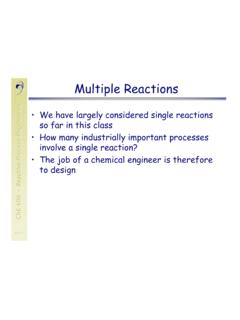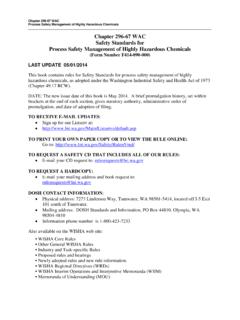Transcription of ITIL V3 Study Guide - brendanmartin.com
1 ITIL V3 Study Guide This Guide is created to assist ITIL V3 Foundation candidates to Study for the certification examination. The Guide is not all encompassing of what you should know but it is a snapshot of the basic terms, concepts, lifecycle stages and processes. This Guide should not be a substitute for studying the course materials in depth and attending a classroom or online course. does not make any claim that studying only this material will result in achieving certification. However, used in combination with self Study , classroom instruction and supplemental approved course materials, you can prepare yourself for the exam thoroughly! Good luck. Key Terms Service A means of delivering value to customers by facilitating Outcomes Customers want to achieve without the ownership of specific Costs and Risks.
2 Service Management A set of specialized organizational capabilities for providing value to customers in the form of services. ITIL (Information Technology Infrastructure Library) a set of best practice guidance for IT Service Management. Proven good practice that is wide industry use. First published in 1980s by the OGC (Office of Government Commerce). Function A team or group of people and the tools they use to carry out one or more processes or activities. A unit of the organization. Role A set of responsibilities, activities and authorities granted to a person or team. Process A structured set of Activities designed to accomplish a specific objective. A process should create value for the stakeholders.
3 Improvement outcomes when compared to before show measurable increase of a desirable metric or decrease of undesirable metric. Benefit the gains achieved as a result of an improvement Baseline a benchmark used as a reference point, which is measured and approved. Snapshot The current state of a configuration as captured by a discovery tool. Capability The intangible assets of an organization including people, process, knowledge, processes, etc. ITIL V3 Study Guide Page 2 of 7 2008, PO Box 1061 Davis, CA 95617 USA Phone + Email - FAX + Resources A tangible asset of an organization including IT infrastructure, money, people or other asset used to deliver a service. Product Manager Owns and manages a set of related services, evaluates market opportunities and customers needs, creates business cases and plans for new service deployment programs.
4 Business Relationship Manager Identifies and documents customer needs. Documents patterns of business activity and user profiles. Identifies correct service level packages for their customers. Core Service An IT Service that delivers outcomes desired by one or more customers. Supporting Service A service that enables or enhances a core service. ROI Return on Investment by measuring the benefit or savings associated with an expenditure over time. VOI Value of Investment in benefits that are non-monetary or long-term outcomes. Service Provider An organization supplying Services to one or more Internal Customers or External Customers. There are three types: Internal, External, Shared. Process Owner Assist with the design, documentation, and performance enhancement of a process by monitoring and improving over time making sure the desired outcome is achieved.
5 Service Owner Responsible to the Customer for the initiation, transition and ongoing maintenance and support of a service over its lifecycle. Supplier Third party responsible fore supplying goods or services to one ore more customers. Business Case a decision support and planning tool that predicts outcomes of a proposed action. Contract A legally binding document between one or more parties to supply goods or services. Utility fit for purpose Warranty fit for use, a defined level of service availability, capacity, continuity and security. CSI Manager Ultimately responsible for the success of all improvement activities. Responsible for the deployment of CSI, communicating the vision and ensuring the success of all improvement activities working with process owners, SLM and SO.
6 Event an alert or notification created by a service or CI typically significant requiring action. Three types of events: exception, warning and information. Alert Something that happens that triggers and event or a call for action. Incident An unplanned interruption or reduction in the quality of an IT Service or could be in the future. Timescales timeframes for each stage of the incident based upon SLA and priority. Model A standard, pre-defined method or template. Used for Incidents, Problems, Requests, Changes, Releases, Deployments & Services Categorization Category type item structure for storing incidents in a database. ITIL V3 Study Guide Page 3 of 7 2008, PO Box 1061 Davis, CA 95617 USA Phone + Email - FAX + Problem The unknown cause of one or more incidents.
7 Known Error The known root case of a problem that has a workaround. Workaround a temporary fix to an incident or problem, or method that makes the customer not reliant on a failed portion of the infrastructure. Service Request A request from a user for information, advice or for a standard change. Access the level and extent of a service s functionality or data that a user is entitled to. Identity information about a user that distinguishes them as an individual. Rights privileges provided with access including read, write, execute, change, delete. Service Measurement ability to predict and report service performance against targets. Service Manager manages the development, implementation, evaluation and on-going management of new and existing products and services.
8 Service Package detailed description of a service and includes SLP, one or more core and supporting services. Service Level Package Defined level of utility and warranty for a particular service package. Functions Service Desk Technical Management Application Management IT Operations Management (includes operations control and facilities management) 3-Processes In Detail Know Objective, Activities, Inputs, Outputs, KPIs, Challenges and Roles Incident Management Change Management Service Level Management Key Concepts Good practice VS Best practice A good practice is standards and frameworks that are established and in wide industry use and it includes proprietary knowledge. Priority=Impact + Urgency Three types of service providers: internal, external and shared.
9 Delivery models insourcing, outsourcing, co-sourcing, partnership or multisourcing, Business Process Outsourcing (BPO), Application Service Provider (ASP) and Knowledge Process Outsourcing (KPO - the most recent form). Service Model a graphical representation of a business opportunity to create value. ITIL V3 Study Guide Page 4 of 7 2008, PO Box 1061 Davis, CA 95617 USA Phone + Email - FAX + Process Model A process (activities, metrics, roles, procedures, instructions, improvements) that uses inputs to create outputs (outcome and review). The process is controlled (owner, objective, documentation, feedback) and enabled (resources and capabilities) and is initiated by a trigger. Service Lifecycle Requirements, defined, analyzed, approved, chartered, designed, developed, built, test, release, operational and retired.
10 The characteristics of a process are MSCR Measureable, deliver Specific results to Customers and Respond to a specific event. The five aspects of Service Design are STAMP: Services, Technologies, Architectures, Metrics and Processes. Conflicting Motives (Balances) Internal vs External, Stability vs Responsiveness, Quality vs Cost, Reactive vs Proactive. RACI Responsibility matrix for the activities of a process that defines who is responsible, who is accountable, who is consulted and who is informed. PDCA The Deming Cycle of Continuous Improvement: Plan, Do, Check, Act. Processes in Service Strategy: Demand Management, Financial Management and Service Portfolio Management. ISSAC IS The seven process in Service Design: IT Service Continuity Management, Supplier Management, Service Catalog Management, Availability Management, Capacity Management, Information Security Management, and Service Level Management.








